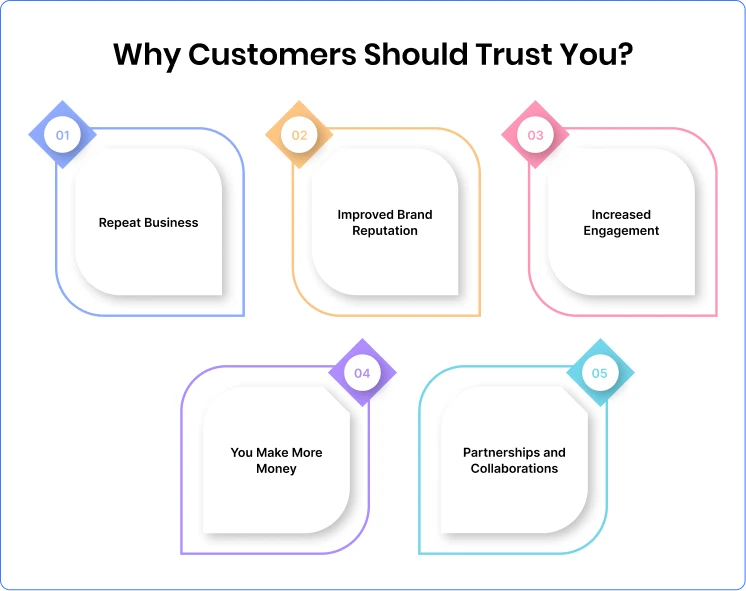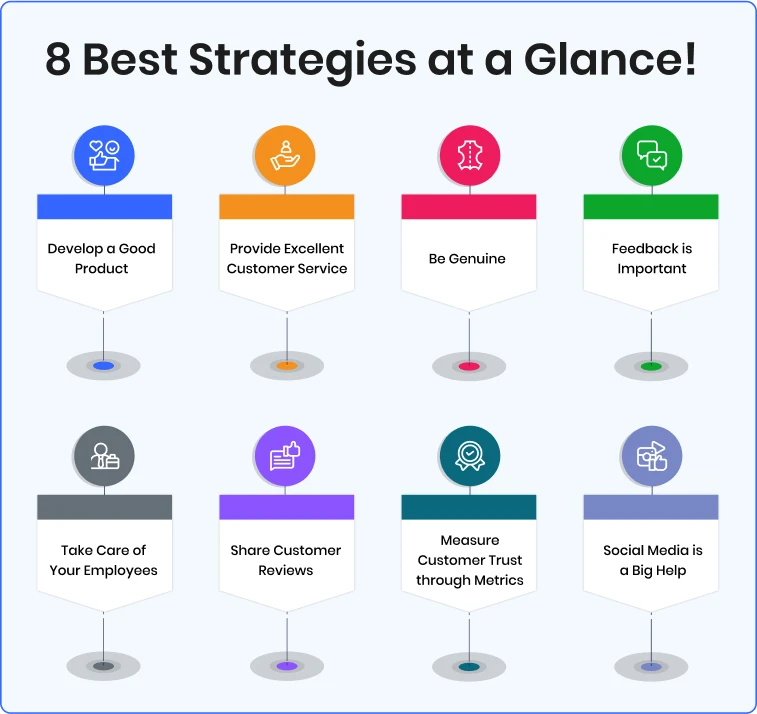Customer Trust: Definition, Benefits, and 8 Strategies to Gain It
- April 12, 2016
- 13 mins read
- Listen

Table of Content
In any business, customer trust is like the building blocks. Even if you’ve got a fantastic product, top-notch customer service, and sales teams, if your customers don’t believe you, your business won’t last for long. It’s a tough reality, that you need to understand.
Research from Gartner shows that nearly 74% of customers want brands to do more than just sell products—they also want good treatment. And a big majority (83%) won’t buy from brands they don’t trust.
In business, trust is super valuable—it’s like money that you earn little by little but can lose all at once. With lots of competition and changing customer needs, brands must think about how to win and keep that faith.
We all aim for our businesses to do well, and customer trust is key. But how do we start? Keep reading to find out why it’s so important, the top 10 ways to gain that faith and loyalty from customers, and some real-life examples from big companies.
What is Customer Trust?
Customer trust means the faith or belief that customers have in a brand, product, or service. It happens when they are sure that a company will always meet their needs, provide good quality, and be honest.
It’s built over time through consistent positive experiences, reliability, transparency, and ethical behavior demonstrated by the business. When customers trust a brand, they feel confident in its products or services, believe in its promises, and are more likely to continue doing business with it.
Why Customer Trust is Important for Your Brand?
For any new business, establishing trust and confidence with customers is crucial. Why would customers choose a new brand? This is the key question. Customers tend to buy from companies they are familiar with, as they feel ‘comfortable’ and ‘trust’ those brands. So, convincing them to believe in a new brand can be a challenging task.
Why building customer trust and loyalty should be your top priorities? Here are a few advantages to look into.
- Repeat Business: Trust leads to loyalty. When customers trust your brand, they’re more likely to return for repeat purchases. This not only boosts your sales but also reduces the cost of acquiring new customers.
- Improved Brand Reputation: Businesses that people trust have good reputations. Happy customers telling others about their positive experiences can bring in new customers and improve the overall brand image.
- Increased Engagement: Trusted brands often have more engaged customers. When people trust a brand, they’re more likely to interact with it, whether it’s through social media, email newsletters, or other channels. This engagement can lead to valuable insights and feedback that can help improve products and services.
- You Make More Money: When customers trust a company’s products or services, they’re likely to buy more often and spend more money each time. This helps the company to increase its overall sales conversions.
- Partnerships and Collaborations: Trust opens doors to partnerships and collaborations with other businesses. Companies are more likely to want to work with brands they trust, whether it’s for co-branded products, joint marketing efforts, or other initiatives.
How to Gain Customer Trust and Confidence: 8 Best Strategies
Remember a time when you let down your customers and lost their trust? If so how did you rectify the situation? Prevent mistakes, in the future? In today’s age, everyone has a platform to share their feedback. Safeguarding your brand reputation and upholding customer confidence is important. How can you achieve this? Here are a few effective strategies worth considering.
1. Develop a Good Product
Most of the companies think too much about whether they are being trusted by customers or not. Instead of that, spend your energy in providing what you have promised to your customers.
Firstly, focus on your product quality because customers always expect you to offer quality services. If you fail on that, they will start looking for other alternatives. For client satisfaction and retention, product quality plays an important role.
Make sure that your product speaks for your brand. Create one such offering that acts as a great solution to the problems of your target audience. We all have several pain points and are in search of a great solution that can solve those.
When you have a good product, customers not only get confident about it but also trust your brand.
Pro Tips:
- Make sure that your product has high quality. Carrying out rigorous tests will help you to identify and address any issues before it is released to the market.
- Take note of the feedback given by customers and incorporate it for further betterment.
- With transparency, customers can learn about pricing, features of your product, and policies. Do not use hidden charges or fraudulent methods that can break trust.
- Convey the benefits and limitations of your product. Do not make unrealistic promises.
2. Provide Excellent Customer Service
Customers want instant assistance with their problems. As per a Salesforce study, 88% of customers indicate that satisfactory customer service increases their likelihood of making repeat purchases.
Apart from traditional email and phone support, more and more companies are moving towards providing real-time customer assistance through live chat and chatbots. Live chat solution lets you offer instant assistance on your website, mobile app, and other social media platforms and the best part is you can manage everything from a single dashboard. Live chat tools let you monitor your users on the web or mobile app in real-time and give information about their past chat history, geographical location, current page views, etc so that you can offer personalized assistance to them.
Apart from live chat, a chatbot is also here to make things easier for you. This AI-powered newest bot automates many of your business operations including customer service when all your support reps are busy with other complex tasks. A chatbot can handle unlimited chat requests at a time and allow you to offer customer support 24/7.
Pro Tips:
- Ensure that you are easily reachable by your customers through various channels such as phone, email, live chat, and social media.
- Make your interactions as much personal as possible.
- Show empathy and understanding towards your customers’ concerns and problems.
- Follow up with customers after their interactions with your business to ensure their satisfaction and to gather feedback for improvement.
- Invest in training your customer service team to handle various situations effectively.
3. Be Genuine
Your customers are smart. They understand well when you are telling the truth or when you are trying to cover up something. If you admit your mistake they will admire and appreciate you rather than playing tricks to fool them or even worse by avoiding the situation altogether.
So always be transparent and genuine to earn customer trust in business. If you have done something unpleasant, rather than hiding it explain how you will solve the issue. Also, make sure that such incidents don’t get repeated in the future.
4. Feedback is Important
Let your customers tell you why they like your products because they are the ones who are actually using them. You can get genuine feedback from them. Collect and implement them for further improvements. When customers get to know that you are genuinely concerned about their feedback and want to work more to make things better, they will trust you more and engage more.
How to ask for feedback?
- Use live chat to get instant feedback from customers.
- Surveys
- Feedback forms
- Social media listening
- Customer interviews
- Focus groups
- Purchase follow-ups
5. Take Care of Your Employees
When employees feel happy and satisfied with their jobs, it also makes customers happier. This is especially true for the teams who directly interact with customers. Customers can sense when an employee isn’t happy in his or her job, which affects how they feel about the company.
However, many times frontline workers feel stressed and undervalued. This is because they have too much work, not enough training, and unclear guidance from their leaders. Happy employees are more engaged, motivated, and attentive, which leads to better customer experiences. Therefore, investing in your employees’ well-being, providing adequate training, recognizing their efforts, and fostering a positive work environment can significantly enhance customer trust in your company.
Pro Tips:
- Invest in ongoing training programs to ensure they stay updated and proficient in their tasks.
- Create a culture of respect, collaboration, and open communication within your organization.
- Acknowledge and appreciate the hard work and dedication of your employees through rewards, incentives etc.
- Regularly seek input from your employees on their experiences and challenges. Listen attentively to their feedback and take proactive steps to address any issues or areas for improvement.
6. Share Customer Reviews
Research shows that “61% of customers read online reviews before making a purchase decision, and they are now essential for e-commerce sites.
Actively seek testimonials from happy customers and display them on your website where people can easily see them. Client satisfaction reviews play an important role in building confidence and increasing sales. Review is something that most people check before making any purchase because it helps to clear any doubts that they may have about the products and services.
7. Measure Customer Trust through Metrics
You won’t understand the effectiveness of your effort unless you measure it. This holds true in every situation, and this case is no exception.
While checking how well your employees or your whole company is doing, it’s also important to look at the right numbers that show customer trust. If you focus more on things like how happy customers are and how many of them stay with you, rather than just how much money you’re making, you’ll notice your company giving customers the best experiences they can get.
How to measure customer trust and loyalty? There are several metrics to follow such:
- Customer Satisfaction Surveys: Run surveys to understand how satisfied your customers are with their overall experience, product quality, service, and support. High satisfaction scores typically indicate trust in your brand.
- Net Promoter Score (NPS): NPS measures how likely customers would recommend your brand to their near and dear ones. A high NPS suggests that customers trust your company enough to endorse it to others.
- Customer Retention Rate: Analyze how many customers continue to do business with your company over time. A high retention rate indicates that customers trust your brand enough to remain loyal.
- Customer Reviews and Testimonials: Monitor online reviews and testimonials to see what customers are saying about your brand.
- Customer Complaints and Resolution: Track the number of customer complaints and how quickly and effectively they are resolved.
- Repeat Purchase Behavior: Measure how often customers make repeat purchases or engage with your brand.
8. Social Media is a Big Help
As per Forbes, 81% of consumers’ purchasing decisions are influenced by their friends’ social media posts.
The truth is if you want your customers to trust your brand, you must engage with them. For instant customer service, social media has become an important way out. Many people will not make the effort to write a letter or email to contact any company. Social media is a platform that makes this whole process of interacting with businesses easier and more accessible. With social media channels like Facebook, Instagram Linkedin, or Twitter, you can be always available for customers.
Customer Trust in Business: 3 Real-Life Examples
Companies really work hard to gain customer trust. Here are 3 great examples for you to see how big giants do it.
1. Puma
PUMA is a big company that makes shoes, clothes, and accessories for sports and everyday wear. They’ve worked with famous athletes, stars, and fashion brands like Usain Bolt, Rihanna, Selena Gomez, and BMW.
Usain Bolt who won many Olympic gold medals and holds world records in sprinting had collaboration with PUMA. He wore PUMA gear during his big races and helped design some products with the brand. This shows how PUMA works with successful people to gain customer trust and loyalty. They’ve teamed up with lots of famous athletes, models, and supporters to do well in different areas and inspire people everywhere.
2. The Ritz-Carlton
The Ritz-Carlton is a fancy hotel chain known for its amazing service. They really care about making their guests happy. Let me tell you a story! Once, a family with a kid who had allergies stayed at the Ritz-Carlton in Bali. They asked for special eggs and milk for their child. But when they got there, they found out the eggs were broken and the milk had gone bad.
Even though the hotel staff tried hard to find those special items nearby, they couldn’t. But the chef had a clever idea. He remembered a store in Singapore that had what they needed. He asked his mother-in-law to buy the stuff and fly to Bali to bring it to the family. She said yes!
This shows how much the staff at Ritz-Carlton cares about their guests. They’ll go to great lengths to gain the loyalty and trust of their customers.
3. Morton’s the SteakHouse
This restaurant chain in America serves delicious food, especially steak and seafood. People trust it for its great service and classy atmosphere. They’ve won lots of awards for their tasty food, excellent service, and nice vibe.
Here’s a cool story about them!
A guy named Peter used to go to Morton’s a lot. Once, he joked on Twitter, asking if they could bring him his favorite steak to the airport. Surprisingly, Alex, who works at the nearest Morton’s, drove over 23 miles to give Peter a full meal at the airport! Someone at Morton’s saw Peter’s tweet, found out where his plane was, and sent Alex with the food. Morton’s cares about its customers. They didn’t just do their job; they went above and beyond to make a funny request happen.
How REVE Chat Can Help You Win Customer Trust?
To earn the trust of your customers, it’s essential to provide top-notch services, excellent support, and personalized experiences. That’s where REVE Chat comes in. It’s among the best all-in-one customer engagement solutions out there, offering instant support across various platforms like websites, mobile apps, and popular social media channels such as Facebook, Instagram, Telegram, Viber, and WhatsApp.
With REVE Chat, you can ensure consistent messaging across all these platforms while managing interactions seamlessly from one central place.
What’s more, REVE Chat includes an advanced AI chatbot that’s built to automate customer support and other business tasks. REVE Chat handles multiple customer interactions at a time, 24/7 after your business hours or, even during peak times when support agents are tied up with other complex tasks.
You can try it out for yourself with REVE Chat’s 14-day free trial, giving you the chance to explore and test all its unique features. So SIGN UP today!





